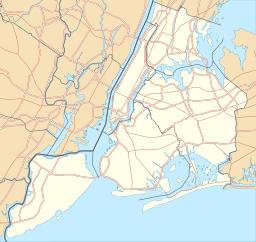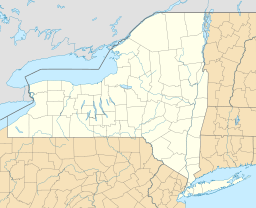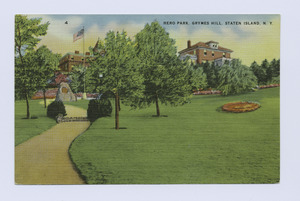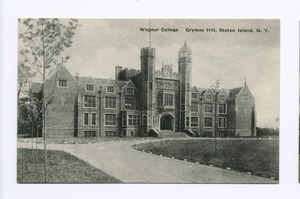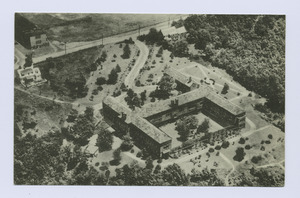Grymes Hill, Staten Island facts for kids
Quick facts for kids Grymes Hill, Staten Island |
|
|---|---|
| Highest point |
Grymes Hill is a cool hill on Staten Island, New York. It stands about 374 feet (114 meters) tall. This makes it the second highest natural spot on Staten Island and in all of New York City. The area around the hill is also called Grymes Hill. It covers about 0.894 square miles (2.315 square kilometers) and is home to over 8,200 people. Parts of the Silver Lake neighborhood are also on Grymes Hill.
Contents
What's in a Name?
Grymes Hill is named after a woman called Cayetana Susana "Suzette" Grymes. She moved to Staten Island in 1836. Suzette was the daughter of Felicidad Fangui and Bartolomé Bosque. She was also married to a famous lawyer from New Orleans, John Randolph Grymes. Her first husband was William Charles Cole Claiborne, who was the first governor of Louisiana.
Suzette's daughter, Athenais Grymes, married a New York banker named Louis A. von Hoffman. He helped start the Knickerbocker Club.
Exploring Grymes Hill's Surroundings
Grymes Hill is surrounded by several other neighborhoods. To the north, you'll find Ward Hill. To the west is Silver Lake. South of Grymes Hill are Sunnyside and Emerson Hill. To the southeast, you'll see Concord. And to the east are Stapleton and Stapleton Heights.
The edges of Grymes Hill are marked by certain streets. Van Duzer Street and Richmond Road define the east side. The Staten Island Expressway and Clove Road mark the south side. On the west is Victory Boulevard. People sometimes disagree on the northern border, with some saying it's Cebra Avenue and others saying it's Louis Street.
The Hill's Shape and Views
Grymes Hill offers amazing views of Lower New York Bay and the Narrows. It's the second highest point on Staten Island, right after Todt Hill. The very top of Grymes Hill is 374 feet (114 meters) above sea level.
Hero Park, which is 3 acres (1.2 hectares) big, sits where Victory Boulevard and Louis Street meet. It's right next to the Notre Dame Academy. The hillsides and trees here are protected by a special rule called the Special Hillsides Preservation District. This rule started in 1987 to keep the area natural.
The Serpentine Art and Nature Commons (SANC) takes care of several walking trails on this protected land. The Trust for Public Land bought 11.5 acres (4.7 hectares) of the hillside. They encouraged neighbors to form SANC to help keep the land as a nature preserve for everyone to enjoy.
In the mid-1800s, breweries dug caves into the hill. They used these caves to make beer. Some of these caves, near Van Duzer Street, later became a popular restaurant. This restaurant even provided food for the movie The Godfather when it was filmed on Staten Island. The restaurant is now closed, and townhouses have been built there.
How the Hill Was Formed
Grymes Hill was shaped by a giant glacier that moved across the land long ago. The hill is part of the Staten Island Serpentinite area. This area has a type of rock called serpentine or soapstone. Where the glacier didn't wear down the rock much, it became soft and yellowish. But where the glacier scraped away the softer parts, the rock is hard, dense, and dark green. The rocks here can be green, yellow, or brown, often with red spots.
A Look Back at Grymes Hill's Past
Grymes Hill was first called Signal Hill. This was because the British had a signal station there. Around 1836, the hill was also known as Castleton Heights.
In 1687, Grymes Hill was part of a large piece of land given to Thomas Dongan. He was the Governor of the Province of New York. Between 1830 and 1833, a local builder named Major George Howard bought 42 acres (17 hectares) of land. This included all the land between Eddy and Louis streets. Major Howard built many of the first homes on the hill. Howard Avenue, the main street on the hill, is named after him. Part of this street was once called Serpentine Road because of the serpentine rock found there.
Life in the Grymes Hill Community
Grymes Hill is considered a very safe neighborhood. It's ranked as the 4th safest out of 229 neighborhoods in New York City by Niche.
The average income for families in Grymes Hill is among the top 15% in the United States. Howard Avenue is known as one of the most exclusive and expensive areas on Staten Island.
Homes in the Area
Most of the homes in Grymes Hill are private houses. Many of them were built for business people from Manhattan. The neighborhood has many beautiful homes from the 1920s that look out over New York Harbor.
In the late 1940s, real estate developer Fred Trump built hundreds of apartments here. These were 423 garden apartments along Howard Avenue and Arlo Road. His son, Donald Trump, who later became a U.S. president, sold these apartments in 2007. Grymes Hill Manor Estates was built in 1953 as rental apartments. In 1983, they became co-op apartments, meaning residents own a share of the building. This complex has 152 apartments around Seth Court, Arlo Road, Howard Avenue, and Stratford Avenue.
Two tall apartment buildings at the bottom of Howard Avenue became condominiums after a big fire in one of them. There are also several apartment buildings on Victory Boulevard. Two new apartment buildings have been built facing the Staten Island Expressway. One became condominiums in 2004, and the other offers housing for senior citizens.
Green Spaces and Parks
The only public park directly on Grymes Hill is Hero Park. It's a 2-acre (0.8-hectare) park that was given as a gift in 1920. However, people living in Grymes Hill can easily walk to the large Silver Lake Park. This park has a running path, a golf course, and public tennis courts. The neighborhood also borders Clove Lakes Park, which has ponds, baseball fields, and a place to rent rowboats.
Grymes Hill also has a steep hillside known as the Serpentine Ridge Nature Preserve. This area is part of the Special Hillsides Preservation District. It's a heavily wooded area that remains natural. It's full of native trees and plants, including some rare or endangered species. The Serpentine Art and Nature Commons keeps up several trails on parts of these hillsides. These lands are owned by the Trust for Public Land.
Grymes Hill also has two cemeteries along Victory Boulevard. Woodland Cemetery is from the 1800s, and some of its gravestones are in German. Silver Lake Cemetery is also from the 1800s and was the first burial site for the Hebrew Free Burial Association.
Learning on Grymes Hill
Grymes Hill is home to two colleges: Wagner College and the Staten Island campus of St. John's University. The St. John's campus is 16.5 acres (6.7 hectares). It used to be a small Catholic college for women called Notre Dame College. That college closed in 1971, and St. John's University took over the campus.
Also on the hill is Notre Dame Academy. This is a Roman Catholic elementary and high school for girls. It received an overall "A" Grade from Niche.
Next to Wagner College is the site of a former Catholic high school called Augustinian Academy. It was run by a group of friars and closed in 1969.
Near the bottom of the hill, on Foote Avenue, is P.S. 35, the Clove Valley School. This school is for kindergarten through 5th grade. It's highly rated by GreatSchools.org and SchoolDigger, and also received an "A" Grade from Niche.
Grymes Hill is also home to Casa Belvedere. This is a center for Italian culture and for learning the Italian language. It is located in the Louis A. and Laura Stirn House. This house was added to the National Register of Historic Places in 2010 and became a NYC Landmark in 2001.
Getting Around Grymes Hill
Grymes Hill is served by several local and limited buses, including the S53, S61, S62, S66, S91, S92 lines. For those traveling to and from Manhattan, the SIM30, SIM35 express buses offer service during rush hour.
Famous People from Grymes Hill's Past
Many interesting people have lived on Grymes Hill over the years:
- Governor Thomas Dongan (1634–1715) – In 1687, he was given a huge piece of land, and Grymes Hill was part of it.
- Daniel D. Tompkins (1774–1825) – He was the sixth Vice President of the United States. In 1815, he bought property on Grymes Hill.
- Suzette Grymes – The woman the hill is named after. She bought land around Howard Avenue in 1836.
- Sir Edward Cunard, 2nd Baronet (1816–1869) – From the famous shipping family, he built his large mansion called "Bellevue" on Grymes Hill around 1851.
- John J. Cisco (1806–1884) – A successful merchant who later became the Assistant Treasurer of the United States in New York.
- Albert Brisbane (1809–1890) – An American who promoted ideas about ideal communities. His house was built in 1854.
- Capt. Jacob Vanderbilt (1807–1893) – Brother of the famous Cornelius "Commodore" Vanderbilt. He built a mansion on Grymes Hill.
- William Greene Ward (1832–1901) – A banker and Civil War colonel whose mansion later became a music building for Wagner College.
- Charles Wallace Hunt (1841–1911) – An inventor and business leader who bought his home on Grymes Hill in 1900.
- W. Butler Duncan I (1830–1912) – A New York banker who bought a mansion on 20 acres from Madame Grymes in 1858.
- Mamie Fish (1853–1915) – A well-known New York socialite during the "Gilded Age."
- John Gans (c.1867–1915) – A steamship company owner. St. John's University's Flynn Hall used to be his home.
- Louis A. Dreyfus (1867–1920) – A local chewing gum maker. His former estate is now part of the Notre Dame Academy.
- William Horrmann (1863–1927) – Owner of a brewing company, he built the impressive Horrmann Castle on Howard Avenue in 1910. The castle was torn down in 1968.
- Edward W. Thompson (1864–1932) – A wealthy sportsman and lumber company head. He lived on Louis Street.
- Louis A. Stirn (c.1864–1962) – A silk importer who built his home in 1908. This mansion is now called Casa Belvedere.
- James J. Murphy (1898–1962) – A United States Representative from New York.
People Living Here More Recently
- Eileen Farrell (1920–2002) – A famous opera singer who lived on Grymes Hill starting in 1944.
- Matthew J. Titone (1961– ) – An American politician and lawyer.
- Colin Jost (1982– ) – A comedic actor, writer, and host for Saturday Night Live.


